Dallas County Continues To Report Near Record High COVID-19 Cases
As local officials continue to report near record high COVID-19 case counts and hospitalizations, vaccine rollout continues, and plans begin to be made for a post-vaccine world, here’s what you need to know today:
- Dallas County reports 2,994 more COVID-19 cases, 21 more deaths;
- CDC expands negative COVID-19 test requirement to all air passengers entering U.S.;
- SMU plans for primarily in-person fall 2021 semester.
Dallas County Reports 2,994 More COVID-19 Cases, 21 More Deaths
Dallas County Wednesday reported 2,994 additional COVID-19 cases–2,589 confirmed and 405 probable–as well as 21 more deaths.
Since the beginning of the pandemic, the county’s reported a cumulative total of 199,948 confirmed cases, 25,681 probable cases, and 1,812 deaths.
The additional deaths reported Wednesday include a Dallas woman in her 40s, a Glenn Heights man in his 40s who died in a hospital emergency room, a Dallas man in his 50s, a Richardson woman in her 50s, a Grand Prairie man in his 50s, a Dallas man in his 60s , a Duncanville man in his 60s, a Grand Prairie man in his 60s who was found dead at his home, a Dallas woman in her 60s, an Irving man in his 60s, a Richardson man in his 60s, a Garland man in his 70s, a Duncanville man in his 70s who didn’t have underlying conditions, a Dallas man in his 70s, a Dallas woman in her 70s, three Dallas men in their 80s, a Carrollton man in his 80s, and a Desoto woman in her 80s. Unless otherwise noted, they had underlying conditions.
Also among the deaths reported Wednesday was a man in his 90s who died at the Dallas long-term care facility where he lived.
“We continue to see high numbers of COVID hospitalizations in Dallas County and throughout the region. UTSW has updated modeling out that predicts Dallas County could have up to 1,900 patients hospitalized for COVID and roughly 3,600 new COVID cases a day by January 22. These are concerning numbers,” said Dallas County Judge Clay Jenkins. “Our hospitals are stretched very thin right now and our healthcare heroes have been working tirelessly since last spring. While we are all thankful the vaccine is here and is being administered as quickly as possible, it will still be some time before it’s widely available to those beyond the 1A and 1B populations.”
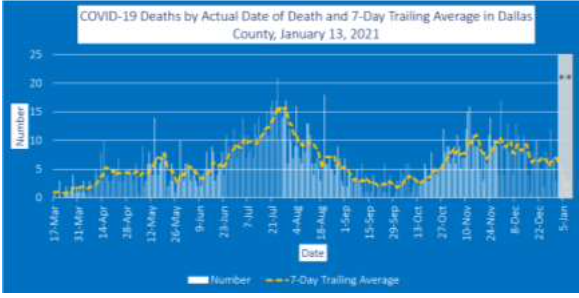
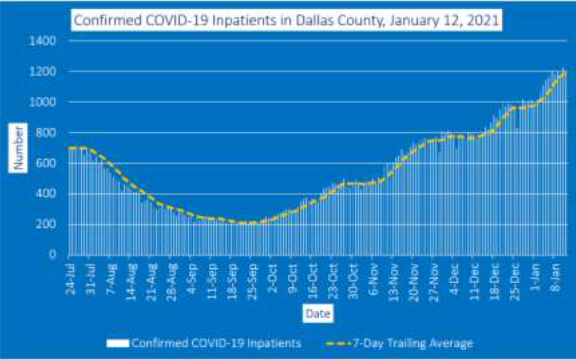
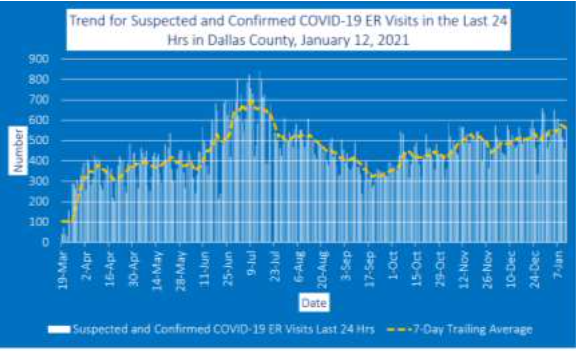
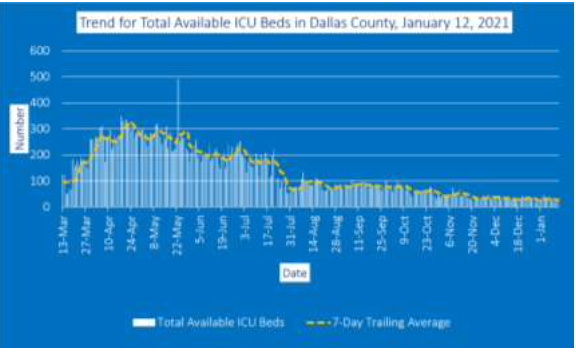
There were 1,197 COVID-19 patients in hospitals in Dallas County Tuesday, and the number of emergency room visits for COVID-19 like symptoms in Dallas County was 572 for the same time-period, which represents around 22% of all emergency department visits in the county according to information reported to the North Central Texas Trauma Regional Advisory Council.
UT Southwestern Medical Center’s data shows COVID-19 hospitalizations in Dallas County increased by 17% over the past two weeks.
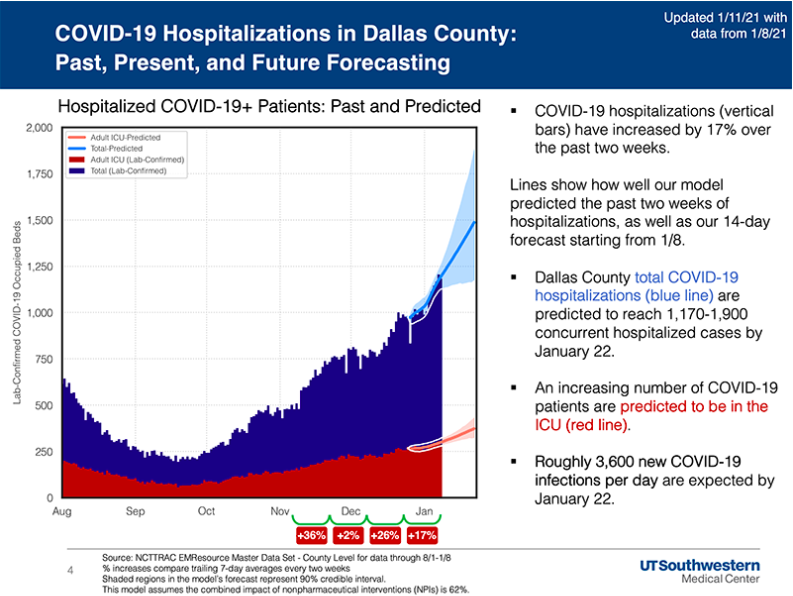
UTSW’s model projects total COVID-19 hospitalizations in Dallas County could reach between 1,170 and 1,900 concurrent hospitalized cases by Jan. 22 and roughly 3,600 new COVID-19 cases per day are expected by Jan. 22.
The provisional seven-day average of daily new confirmed and probable cases for the week ending Jan. 2 was to 2,227, which is a rate of 84.5 daily new cases per 100,000 residents—the highest case rate in Dallas County since the beginning of the pandemic.
The percentage of respiratory specimens testing positive for the virus that causes COVID-19 remains high, with 31% of symptomatic patients presenting to area hospitals testing positive in the week ending Jan. 2.
The county also reported 109 active long-term care facility outbreaks.
A total of 3,286 residents and 1,871 healthcare workers in long-term facilities in Dallas have been diagnosed with COVID-19. Of these, 709 have been hospitalized and 378 have died. About 22% of all deaths reported to date have been associated with long-term care facilities.
There have also been 34 outbreaks of COVID-19 in congregate-living facilities like homeless shelters, group homes, and halfway homes have been reported in the past 30 days associated with 84 cases.
Over the past 30 days, there have been 7,310 COVID-19 cases in school-aged children and staff reported from 674 separate K-12 schools in Dallas County, with 1,842 of these cases reported during the last week of December.
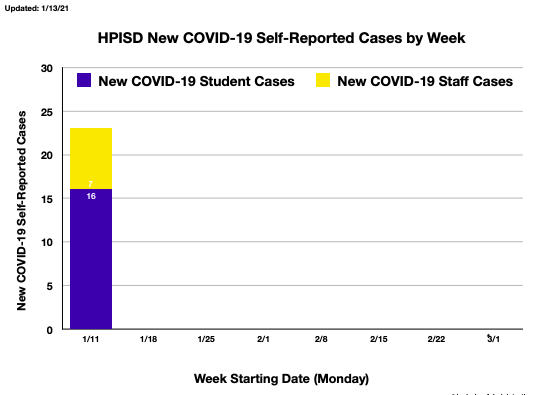
As of Wednesday, Highland Park ISD’s reported three cases among staff members assigned to Armstrong Elementary, five among students there, two cases among staff members assigned to Boone Elementary, three among students there, two cases among students at Bradfield, four cases among students at University Park, two cases among staff members at McCulloch Intermediate, two among students there, two cases among students at Highland Park Middle School, three cases among staff members assigned to Highland Park High School, and 22 among students there, according to the district’s COVID-19 webpage.
As of Wednesday, Dallas ISD reported 3,134 total cases districtwide, 1,542 among campus staff, 344 among central staff, and 1,248 among students, according to the district’s COVID-19 dashboard.
Since the beginning of the pandemic, a total of 41 cases of COVID-19 have been reported among school nurses and nurse assistants—almost half (19) of which have been diagnosed within the past week.
The county says one COVID-19 outbreak in a school in December originated with spread among 11 staff members, with transmission to nine students, and subsequent COVID-19 infections documented among at least eight household members of these students. One death and one hospitalization occurred from this outbreak.
CDC Expands Negative COVID-19 Test Requirement to All Air Passengers Entering U.S.
The Centers for Disease Control and Prevention (CDC) announced Tuesday it’s expanding the requirement for a negative COVID-19 test to all air passengers entering the U.S.
Variants of the virus that causes COVID-19 continue to emerge in countries around the world, and there is evidence of increased transmissibility of some of these variants, the CDC says.

Before departure to the U.S., a required test, combined with the CDC recommendations to get tested again 3-5 days after arrival and stay home for seven days post-travel, will help slow the spread of COVID-19 within US communities from travel-related infections, the CDC says. Pre-departure testing with results known and acted upon before travel begins is also meant to help identify infected travelers before they board airplanes.
Air passengers are required to get a viral test (a test for current infection) within the three days before their flight to the U.S. departs, and provide written documentation of their laboratory test result (paper or electronic copy) to the airline or provide documentation of having recovered from COVID-19. Airlines must confirm the negative test result for all passengers or documentation of recovery before they board. If a passenger does not provide documentation of a negative test or recovery, or chooses not to take a test, the airline must deny boarding to the passenger.
“Testing does not eliminate all risk,” said CDC Director Robert R. Redfield. “But when combined with a period of staying at home and everyday precautions like wearing masks and social distancing, it can make travel safer, healthier, and more responsible by reducing spread on planes, in airports, and at destinations.”
This order was signed by the CDC Director Jan. 12 and will become effective on Jan. 26.
SMU Plans for Primarily In-Person Fall 2021 Semester
SMU President R. Gerald Turner announced Tuesday plans for a primarily in-person fall 2021 semester.
“With the understanding that vaccinations for COVID-19 will be offered widely this spring, including on our own campus, we are planning to return to regular on-campus courses and activities by fall,” a letter from Turner posted on the university’s website reads.
In the meantime, Turner’s letter notes the university remains “vigilant” regarding COVID-19 prevention and safety measures.
“We also will continue to carefully monitor health trends and create contingency plans so we are ready to meet any new challenges that might arise, the letter says.









